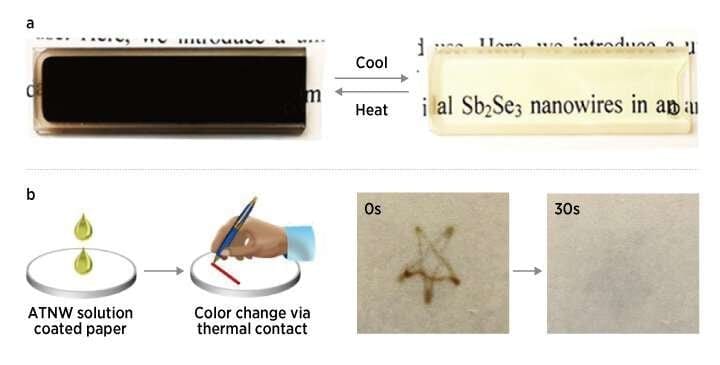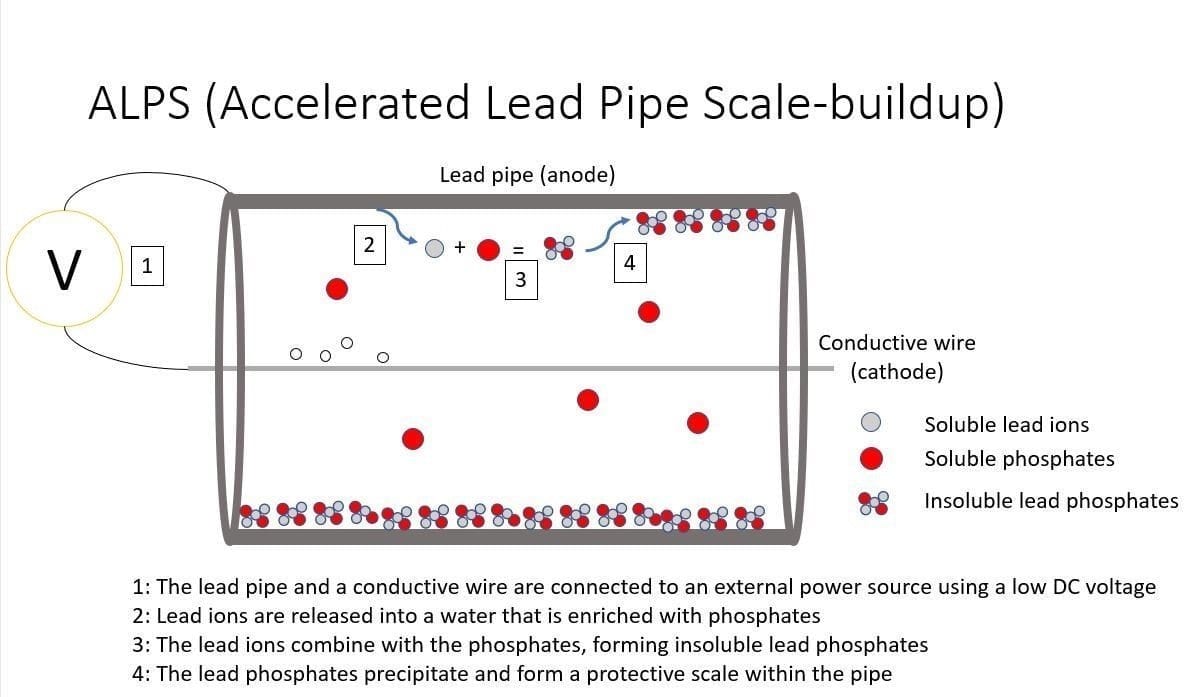
The thermochromic liquid changing color in reaction to a change in temperature
Nanowires that form and disperse as the temperature changes form the basis of a robust thermochromic liquid
A smart liquid that darkens dramatically in response to rising temperature has been developed by researchers at A*STAR. The nanowire-based thermochromic liquid’s tunable color-changing behavior was retained even after hundreds of heat-cool cycles. This liquid could have applications ranging from smart windows to paper-based temperature sensors, the researchers say.
Previous thermochromic liquids have usually been based on organic dyes or liquid crystals. Although amenable to industrial-scale production, organic dyes tend to degrade upon exposure to light, while liquid crystals require encapsulation to avoid degradation in air. A thermochromic liquid that overcomes these limitations has been discovered by Wen-Ya Wu and her colleagues from the A*STAR Institute of Materials Research and Engineering, in collaboration with researchers at the National University of Singapore.
Wu’s research is focused on semiconductor nanocrystals, which form a colloidal suspension in certain solvents, and which are known for their broad light absorption and high photostability. “While exploring the synthesis of colloidal antimony selenide (Sb2Se3) nanoparticles, we serendipitously discovered that they formed crystalline nanowires upon heating and dissolved into their molecular precursors upon cooling, in a certain mixture of solvents,” Wu says.
Thanks to their broad light-absorbing behavior, a vial of Sb2Se3 nanowires formed by heating can appear very dark. But a solution of their molecular precursors, which the nanowires revert to upon cooling, are relatively transparent. “This phenomenon formed the basis for developing these materials as liquid-based thermochromics,” Wu says.
The team showed that the thermochromic liquid’s color-changing behavior is long-lived and robust. A solution of the molecular precursors was stable even after two years in ambient conditions, and could be heated and cooled hundreds of times without any loss of performance. An additional advantage was that the color change transition temperature could be tuned to be anywhere between 35 and 140 degrees Celsius by simply adding a small amount of tin chloride to the mixture. The tin species interact with the selenium precursor, reducing the temperature for nanowire growth.
When the researchers coated their thermochromic solution on to filter paper, they showed that it could differentiate between cooler and hotter regions of an irregularly heated surface. “Our liquid-based thermochromic system potentially allows coating on to a large variety of surfaces,” Wu says. One potential avenue is self-regulating windows that darken on hot days.
The team next plans to use transmission electron microscopy to study the mechanism of reversible nanowire growth, to aid the rational design of new colloidal nanomaterial thermochromics.
Learn more: Smart liquid goes dark in the heat
The Latest on: Colloidal nanomaterial thermochromics
[google_news title=”” keyword=”colloidal nanomaterial thermochromics” num_posts=”10″ blurb_length=”0″ show_thumb=”left”]
via Google News
The Latest on: Colloidal nanomaterial thermochromics
- Researchers develop nanotechnology for creating wafer-scale nanoparticle monolayers in secondson May 7, 2024 at 1:17 pm
Nanoscale materials present us with astonishing chemical and physical properties that help materialize applications such as single molecular sensing and minimally invasive photothermal therapy—which ...
- Colloidal Electrolyteson May 3, 2024 at 5:01 pm
COLLOIDAL electrolytes are among the commonest of substances, probably more numerous than acids and bases. I have denned this class as electrolytes in which at least one of the ions is replaced by ...
- Advancing responsive colloidal nanomaterials with virus-polymer crystalson May 2, 2024 at 5:00 pm
Notably, this assembly process occurs spontaneously without chemically modifying the viruses, setting it apart from previous techniques that require laborious genetic alterations or additional ...
- Nanotechnology Newson May 1, 2024 at 5:00 pm
Apr. 25, 2024 — A newly developed nanomaterial that mimics the behavior of proteins could be an effective tool for treating Alzheimer's and other neurodegenerative ... 'Like a Nanoscopic Moon ...
- Colloidal Silver: Is It Safe?on April 17, 2024 at 5:00 pm
“Colloid” means that something is dissolved in another substance. Colloidal silver is made up of tiny particles of silver in water. It’s the same kind of silver used in jewelry and silverwar ...
- Two-dimensional nanomaterial sets expansion recordon April 17, 2024 at 2:08 pm
Noah Stocek, a Ph.D. student collaborating with Western physicist Giovanni Fanchini, has developed a new nanomaterial that demonstrates the opposite of this phenomenon. Working at Interface ...
- Colloidal Suspension Rheologyon December 4, 2023 at 10:25 pm
To register your interest please contact [email protected] providing details of the course you are teaching. Colloidal suspensions are encountered in a multitude of natural, biological and ...
- Colloidal oatmeal is the dry skin soother that’s perfect for winter-ravaged skinon February 8, 2023 at 1:16 am
And there’s one hero ingredient they all champion: colloidal oatmeal. Once a home remedy for chicken pox and eczema, colloidal oatmeal is not new. A fine powder made from ground oats ...
- Nanomaterials Databaseon May 19, 2022 at 8:49 pm
If 50% or more of the constituent particles of a material in the number size distribution have one or more external dimensions in the size range 1 nm to 100 nm, then the material is a nanomaterial.
- The world of colloidal silicaon November 7, 2019 at 5:01 pm
But colloidal silica can also stabilize the ground under buildings during earthquakes and stop the spread of toxic pollutants below ground. This versatile nanomaterial not only preserves ancient ...
via Bing News










